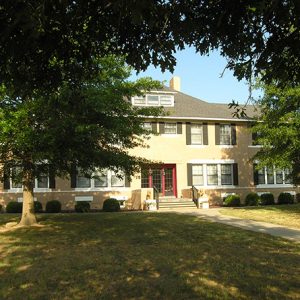calsfoundation@cals.org
Twelve Oaks
The Twelve Oaks estate, located in a rural setting just south of Harrison (Boone County), is listed on the National Register of Historic Places, which notes its local significance for its Craftsman- and Colonial Revival–style architecture. The house is one of the best examples of a Craftsman/Colonial Revival estate—and an unusually large example of the style—in the Harrison area.
With the rise of the railroad industry in Harrison in the early twentieth century, a building boom hit the city. Among those who had worked on many high-profile buildings in Harrison was J. W. Bass, a steel contractor based in Detroit, Michigan. His J. W. Bass Erecting Company and Atlas Iron & Steel Company had offices in Detroit; Chicago, Illinois; and Cleveland, Ohio. The company had worked on several nationally known buildings, including the Commercial-Appeal Building, the Illinois Central Depot, Tennessee Trust, Goodwin Institute, and the Gayoso Hotel, all in Memphis, Tennessee; as well as the Union Depot in Cleveland. Bass—along with his wife, Agnes—quickly became one of the largest property holders in Harrison, as he helped build the Montgomery Ward Building, the Lyric Theater, and the Mitchell Building, all of which are also listed on the National Register. Bass later became the president of Security Bank, serving until his death in 1932, after which his wife took over his position.
In the early 1920s, the Bass family, searching for a place to make a second home, purchased a parcel of land just to the south of Harrison from the Wilson family. By 1922, Bass had erected a substantially sized Craftsmen-influenced home on the site. The estate derived its name, Twelve Oaks, from the twelve large oak trees on the lawn of the property. The farm grew to roughly 1,600 acres of farmland and orchards, on which Bass raised his famous thoroughbred Hereford cattle.
The house was one of the truly luxurious houses in the area when it was built. The local newspaper reported of the house, “It was a home that we may all have dreamed but never before seen in reality.” In addition to the main house, there were seven outbuildings constructed at the same time. A small house (which served as the residence of farm manager Alvin Parker), a smokehouse, a barn, a garage with lodging for the driver, a carriage house with rooms for the servants, and a pump house were all built around the main house. Two gazebos and many concrete fence posts were also constructed on the property.
Bass had the house built in the Craftsman style, which was one of the most popular architectural styles during the first decades of the twentieth century. It was a style that emphasized the craftsmanship and materials that went into a building’s construction. The Twelve Oaks estate, with its abundance of stonework composed of stones that originated from the area around Harrison, along with its exotic interior, exhibits the emphasis on craftsmanship and materials that is a key characteristic of the Craftsman style.
After a several-months-long trip to California, Agnes Bass returned to Harrison enamored with Mission and Spanish Colonial architecture. She decided to change the exterior of the home to reflect her new architectural tastes. The exterior stone was replaced with stucco around 1940.
J. W. Bass died at Detroit’s Grace Hospital on July 23, 1932. His wife lived in the house until her second husband, James M. Shinn, died in 1947. The house has sold twice since the Bass and Shinn families owned it, first to state Senator Roy Milum and his wife, who lived there for fifteen years until 1964, when it was sold to Harold and Dorothy Allen.
On Friday, April 20, 1973, the entire property was damaged by a tornado that roared through Harrison. The remaining oak trees, from which the property was named, were uprooted, and the barn and garage were demolished. Due to its solid construction, the house remained without any major damage, only permanently losing its front porch and needing shingles and several windows replaced.
For additional information:
Rice, Will. “Beautiful Country Home of Mr. and Mrs. J. W. Bass, the Finest in Arkansas.” Harrison Daily Times, Hotel Seville Souvenir Section, September 24, 1929, p. 4.
“Twelve Oaks.” National Register of Historic Places nomination form. On file at Arkansas Historic Preservation Program, Little Rock, Arkansas. Online at http://www.arkansaspreservation.com/National-Register-Listings/PDF/BO0027.nr.pdf (accessed November 4, 2021).
Travis A. Ratermann
Arkansas Historic Preservation Program
 Early Twentieth Century, 1901 through 1940
Early Twentieth Century, 1901 through 1940 Historic Preservation
Historic Preservation Twelve Oaks
Twelve Oaks  Twelve Oaks
Twelve Oaks 



Comments
No comments on this entry yet.